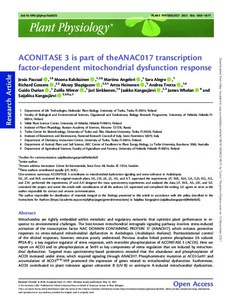ACONITASE 3 is part of the ANAC017 transcription factor-dependent mitochondrial dysfunction response
Kangasjärvi Saijaliisa; Rahikainen Moona; Pascual Jesús; Angeleri Martina; Winter Zsófia; Heinonen Arttu; Kangasjärvi Jaakko; Durian Guido; Trotta Andrea; Sinkkonen Jari; Alegre Sara; Whelan James; Shapiguzov Alexey; Gossens Richard
https://urn.fi/URN:NBN:fi-fe2021120158434
Tiivistelmä
Mitochondria are tightly embedded within metabolic and regulatory networks that optimize plant performance in response to environmental challenges. The best-known mitochondrial retrograde signaling pathway involves stress-induced activation of the transcription factor NAC DOMAIN CONTAINING PROTEIN 17 (ANAC017), which initiates protective responses to stress-induced mitochondrial dysfunction in Arabidopsis (Arabidopsis thaliana). Post-translational control of the elicited responses, however, remains poorly understood. Previous studies linked protein phosphatase 2A subunit PP2A-B’γ, a key negative regulator of stress responses, with reversible phosphorylation of ACONITASE 3 (ACO3). Here we report on ACO3 and its phosphorylation at Ser91 as key components of stress regulation that are induced by mitochondrial dysfunction. Targeted mass spectrometry-based proteomics revealed that the abundance and phosphorylation of ACO3 increased under stress, which required signaling through ANAC017. Phosphomimetic mutation at ACO3-Ser91 and accumulation of ACO3S91D-YFP promoted the expression of genes related to mitochondrial dysfunction. Furthermore, ACO3 contributed to plant tolerance against UV-B or antimycin A-induced mitochondrial dysfunction. These findings demonstrate that ACO3 is both a target and mediator of mitochondrial dysfunction signaling, and critical for achieving stress tolerance in Arabidopsis leaves.
Kokoelmat
- Rinnakkaistallenteet [19207]
